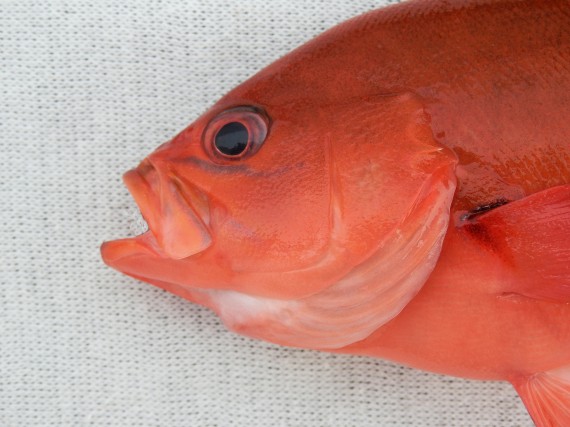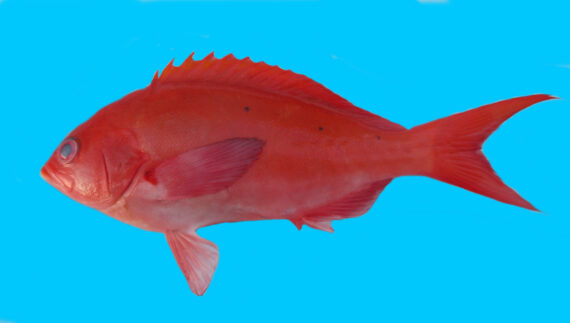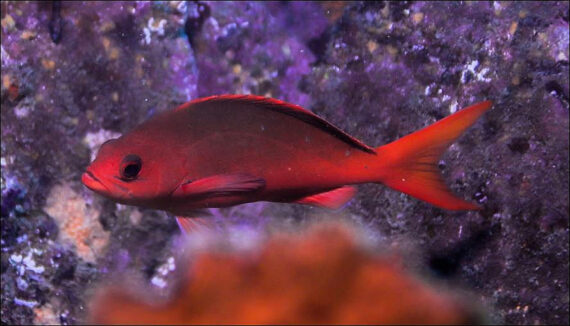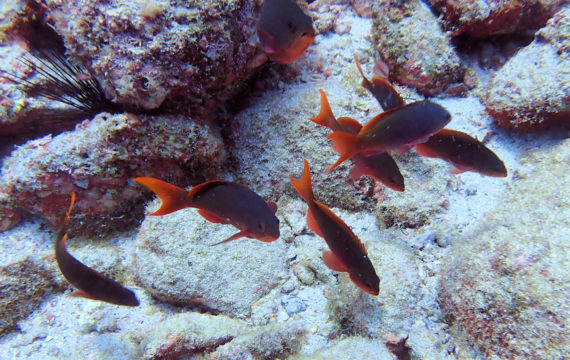Pacific Creolefish, Cephalopholis colonus
 Pacific Creolefish, Cephalopholis colonus, Juvenile. Fish caught from coastal waters off Point Palmilla, Baja California Sur, July 2015. Length: 20 cm (7.9 cm). Note the blue line under the eye not seen in the adults.
Pacific Creolefish, Cephalopholis colonus, Juvenile. Fish caught from coastal waters off Point Palmilla, Baja California Sur, July 2015. Length: 20 cm (7.9 cm). Note the blue line under the eye not seen in the adults.
 Pacific Creolefish, Cephalopholis colonus, Juvenile. Fish caught from coastal waters off Point Palmilla, Baja California Sur, October 2021. Length: 20 cm (7.9 cm). Note the blue spots on the sides not seen in the adults.
Pacific Creolefish, Cephalopholis colonus, Juvenile. Fish caught from coastal waters off Point Palmilla, Baja California Sur, October 2021. Length: 20 cm (7.9 cm). Note the blue spots on the sides not seen in the adults.
 Pacific Creolefish, Cephalopholis colonus. Fish caught from coastal waters off Loreto, Baja California Sur, February 2025. Length: 30 cm (12 inches).
Pacific Creolefish, Cephalopholis colonus. Fish caught from coastal waters off Loreto, Baja California Sur, February 2025. Length: 30 cm (12 inches).
 Pacific Creolefish, Cephalopholis colonus. Fish caught from coastal waters off Point Palmilla, Baja California Sur, December 2011. Length: 36 cm (14 inches). This fish will significant darken post death.
Pacific Creolefish, Cephalopholis colonus. Fish caught from coastal waters off Point Palmilla, Baja California Sur, December 2011. Length: 36 cm (14 inches). This fish will significant darken post death.
 Pacific Creolefish, Cephalopholis colonus, Albino. Fish provided by the commercial fishermen of the greater Los Cabos area, Baja California Sur, November 2014. Length: 38 cm (15 inches). Most unusual!
Pacific Creolefish, Cephalopholis colonus, Albino. Fish provided by the commercial fishermen of the greater Los Cabos area, Baja California Sur, November 2014. Length: 38 cm (15 inches). Most unusual!
 Pacific Creolefish, Cephalopholis colonus. Fish caught from coastal waters off Loreto, Baja California Sur, February 2025.
Pacific Creolefish, Cephalopholis colonus. Fish caught from coastal waters off Loreto, Baja California Sur, February 2025.
 Pacific Creolefish, Cephalopholis colonus. Underwater photograph taken in coastal waters off Puerto Vallarta, Jalisco, September 2021. Photograph courtesy of Kevin Erwin, Seattle, Washington.
Pacific Creolefish, Cephalopholis colonus. Underwater photograph taken in coastal waters off Puerto Vallarta, Jalisco, September 2021. Photograph courtesy of Kevin Erwin, Seattle, Washington.
 Pacific Creolefish, Cephalopholis colonus. Underwater photograph taken in Zihuantanejo Bay, Guerrero, August 2019. Photograph courtesy of Maude Jette, Dive Zihuantanejo, www.Divezihuantanejo.com.
Pacific Creolefish, Cephalopholis colonus. Underwater photograph taken in Zihuantanejo Bay, Guerrero, August 2019. Photograph courtesy of Maude Jette, Dive Zihuantanejo, www.Divezihuantanejo.com.
The Pacific Creolefish, Cephalopholis colonus, is a member of the Grouper or Epinephelidae Family, that is known in Mexico as ticaretta, sandia (watermelon!) and cardinal. Globally there are twenty-six two species in the genus Cephalopholis, five of which are found in Mexican waters, three in the Atlantic and two in the Pacific Ocean.
The Pacific Creolefish have a uniform red color that is darker dorsally and a row of 4 or 5 light blue spots along their back below their dorsal fin (which fade quickly after collection). A very small percentage of the population is darker with olive brown coloration; those fish are found in much shallower environments from depths of less than 25 m (82 feet). Their anal fin has 3 spines and 9 to 11 rays; their caudal fin is large, moon shaped and deeply forked; and, their dorsal fin has 9 dorsal spines and 18 to 21 rays.
The Pacific Creolefish are found in small aggregations within reefs at depths up to 99 m (325 feet). They reach a maximum of 43 cm (17 inches) in length and less than 1 kg (2 lbs 3 oz) in weight. As of January 1, 2024, the International Game Fish Association world record stood at 0.79 kg (1 lb 12 oz) with the fish caught by my good friend Chris Wheaton in coastal waters off Loreto, Baja California Sur in April 2017. Although they are widespread and fairly abundant, the Pacific Creolefish is poorly studied with very limited information available about their lifestyle and behavioral patterns including specific details on age, growth, longevity, movement patterns, diet, habitat use, and reproduction.
The Pacific Creolefish is a resident of all Mexican waters of the Pacific Ocean, however their populations are diminished in the northern part of the range.
The Pacific Creolefish is a very easy fish to identify and cannot be confused with any other species from the Pacific Ocean. They are however very similar to the Atlantic Creolefish, Paranthias furcifer.
From a conservation perspective the Pacific Creolefish is currently considered to be of Least Concern with stable, widely distributed populations. They are sold fresh in the major Mexican food markets throughout Mexico on a limited basis. They are difficult to catch via hook and line as they feed on planktonic organisms due to their shortened snout which facilitates close-range binocular vision. I have caught these with some regularity during colder water months in shallow water using small hooked Sabiki rigs tipped with cut squid. Chris Wheaton indicates that they can be caught with some regularity north of Loreto near Punta Pulpito on 4 to 5-inch iron jigs. They are considered to be an exceptional food fish.